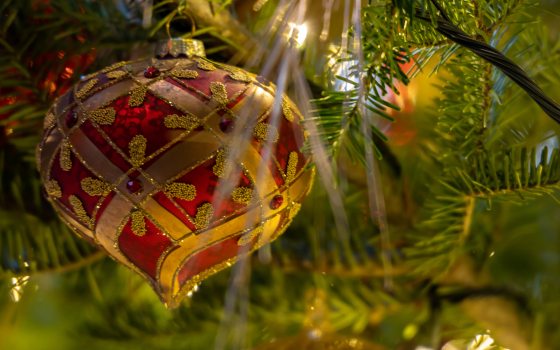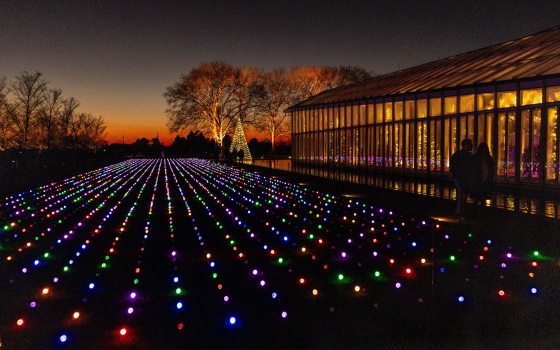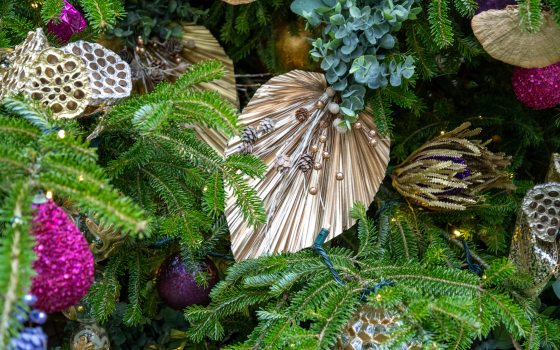This Christmas, our Conservatory is a vision of artful botanical splendor. Our trees are dressed and draped in everything from preserved to fresh florals, living plants, imaginative garland, and much more … including about 20,000 ornaments from our expansive total collection of more than 67,000 ornaments in more than 600 different styles, from baubles to icicles. Our ornaments are a key component in making our Christmas display come to life, and there are many factors that go into their selection. Follow along as we track the process behind selecting Longwood ornaments for display, and where each spends most of its time alongside 66,999 of its closest friends.
We begin planning each year’s A Longwood Christmas display about a year in advance. The project leader of each display area—from the Music Room to the Ballroom, the Peirce-du Pont House to the Meadow Garden—comes up with a vision or intent for that space, and then works with our display design staff on that aesthetic. Once a display area’s vision is finalized, it is then determined what size tree—or trees—will be needed in that space, as well as how many styles of ornaments are needed to fill each tree. From there, the number of ornaments needed for that particular display space is calculated.
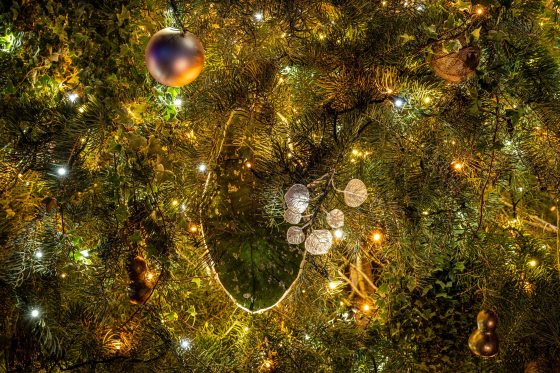
Our Gardener’s Tree, a 24-foot white fir (Abies concolor) is decorated with matte and gloss ornaments in blush and champagne, with accents of pinecone sections and burlap ornaments. Live variegated English ivy (Hedera helix) and preserved Magnolia macrophylla leaves are also on the tree. Photo by Eileen Tercha.
Given the size and shape of each design area, the number, location, and sizes of the trees may be fairly consistent from year to year, but the type of tree—from Fraser fir to Douglas fir to in between—can affect how many ornaments may be placed on them. Fraser firs, for example, tend to be skinnier trees with strong branches, so they can accommodate larger ornaments deeper inside the tree. A Concolor fir, in contrast, tends to be rounder with more flexible branches, so thought needs to be given as to how heavy the ornaments are and where we place them on the branches. Throughout the planning process, our staff references a running spreadsheet that lists the size and types of trees used in past displays and the number and types of ornaments used on them. Each tree will need a certain number of large, medium, and small ornaments, so each ornament is chosen according to its color, size, finish (matte or glossy), shape, texture, quantity, and relevance to the overall display theme and aesthetic. Images of all the tens of thousands of ornaments owned by Longwood are housed in a large red binder, simply labeled “ornament book”, from which the project leader of each area chooses his or her ornaments out of the hundreds of options. Once selected, those chosen ornaments are then pulled from the barn on Longwood’s property; it’s here that they’re stored in numbered boxes for the majority of the year before they’re staged in our Conservatory and beyond and then put on display.
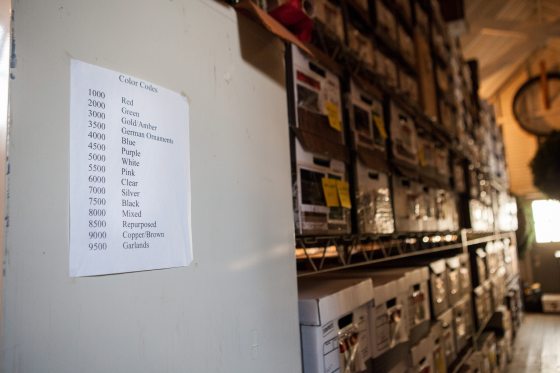
In the barn, staff refer to a color coding system to help find specific ornaments. Photo by Morgan Horell.
Each year, we select the ornaments for the Music Room first—not only because that space helps tell the story of that year’s theme, but also because of its history. When founder Piere S. du Pont opened the Longwood Conservatory in 1921, one of the Conservatory’s primary uses was as a place of grand entertainment. The Music Room, located at the north end of the Exhibition Hall, was built in 1923 as a smaller place for the du Ponts to host more intimate gatherings. This year, for this absolutely breathtaking space outfitted to resemble a bustling floral shop at the holidays, we selected one 18-foot Fraser fir for the Music Room, and an inspiration basket of ornaments, selected for their ability to complement the space and the theme, was assembled for consideration in spring 2022. After an inspiration basket is assembled, it’s then taken to the designated area to see how well the ornaments work together in the lighting of that space. Ornaments are then changed out until the perfect combination is achieved.
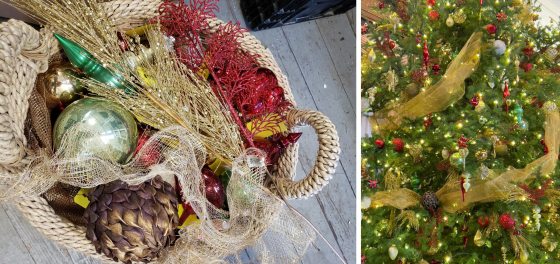
This year’s Music Room ornaments—shown in their inspiration basket on the left, and on display on the right—come from the red, gold, champagne, and mint green color sections of Longwood’s ornament collection—many of which featuring shiny finishes to help them stand out. Left photo by Kirsten Berlin; right photo by Eileen Tercha.
Once our ornament selection for a given space is finalized, we also select ribbon, as well as dried and preserved materials to complement the theme. Then, once all of the tree’s decorations have been finalized, the rest of that space’s décor is influenced by what has been chosen for that space’s tree or trees.
Beyond the Music Room, the ornaments showcased in other areas of the Gardens and the Conservatory are positively dazzling.
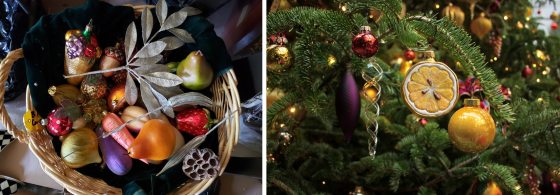
In the Peirce-du Pont House you will find an abundance of fruit- and vegetable-themed ornaments, spurred by the inspiration basket (left). Left photo by Kirsten Berlin; right photo by Scott Hummel.
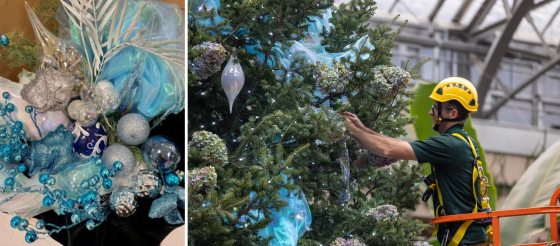
In the East Conservatory, you will find trees decorated with ornaments in the color palette of silver and gold with pink and blue accents as well as clear, white, and iridescent ornaments. Outdoor Landscape Manager Roger Davis places ornaments on the East Tree in the East Conservatory during A Longwood Christmas install. Left photo by Olivia Fow; right photo by Carol Gross.
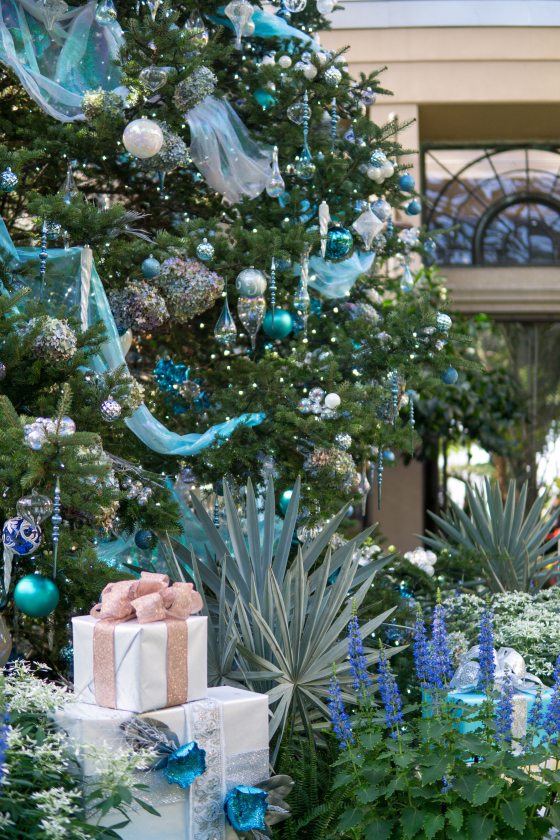
The completed East Conservatory tree. Photo by Holden Barnes.
As you walk around the Gardens you will find that not all ornaments have a long life like the ones stored in our barn. Some are made specifically for that year’s display out of items found out in the natural areas of our Gardens. These ornaments are assembled by a group of dedicated volunteers who gather objects, cut, paint, and/or glue them together to make wonderful ornaments that are enjoyed by our human and wildlife guests alike. You will find these in the form of pinecones stuffed with suet to bundles of spray millet, red broom corn, and flax on the Wildlife Tree located between Flower Garden Drive and the Small Lake.
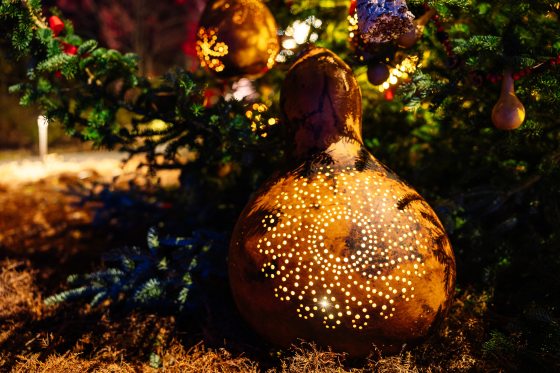
At the Wildlife Tree, you’ll also find large gourds punctuated with handmade patterns lit from within to add a glowing element to this nutrient-rich tree designed for our wintering wildlife. Photo by Becca Mathias.
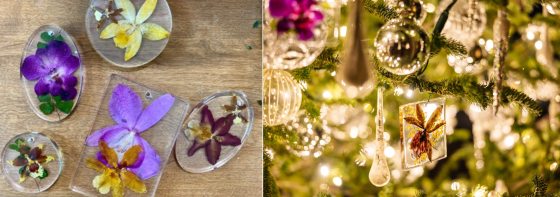
Each year new ornaments are purchased or made especially for that year’s display like these pressed orchid ornaments made by The Garden Shop Visual Experience Manager Kaitlin Dodds, featured on the tree in the Silver Garden. Left photo by Olivia Fow; right photo by Becca Mathias.
At Longwood, each and every Christmas ornament is one of importance and interplay—selected to be seen, to be appreciated, to add another beautiful element to our display. Some may play prominently in the display, while others are more subtle, but they are all important in creating the magic that is A Longwood Christmas. Come see them all for yourself during A Longwood Christmas, on view through January 8.
